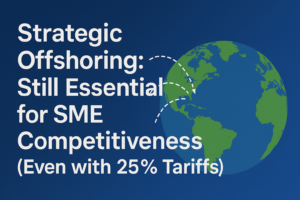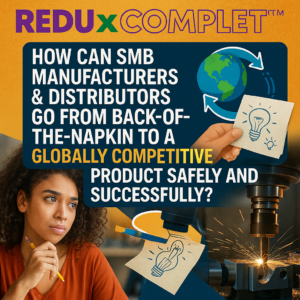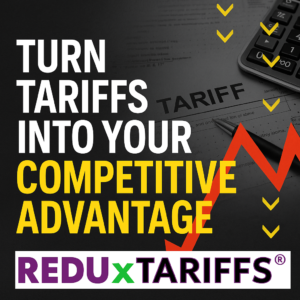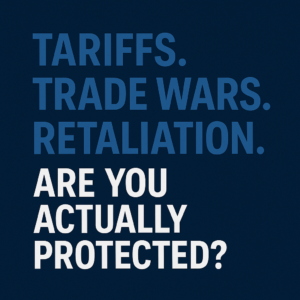
Tariff Tsunami Imminent: How to Safeguard Your Manufacturing Future Without Sacrificing Growth
The impending 25% tariffs on Canadian and Mexican goods entering the United States, set to trigger on March 4th, are not just a trade skirmish; they’re a full-blown economic earthquake. For manufacturers across North America, the stakes couldn’t be higher. This isn’t about political rhetoric; it’s about survival and strategic agility in a rapidly shifting global landscape.
The Canadian Conundrum:
Canadian manufacturers, long reliant on seamless cross-border trade with the US, face an existential threat. The 25% tariff will immediately erode profit margins, making Canadian-made goods significantly less competitive. For industries like automotive and aerospace, where tight integration with US supply chains is paramount, this tariff acts as a sledgehammer, disrupting established flows and potentially forcing plant closures. Regions like Ontario, heavily reliant on automotive manufacturing, will be particularly vulnerable. As reported by the Financial Post, “Canada’s economy could face significant headwinds as a result of the tariffs, with manufacturing sectors bearing the brunt of the impact.”<sup>1</sup>
Mexican Manufacturing Under Siege:
The impact on North American manufacturers with contract manufacturing (CM) in Mexico is equally dire. While Mexico has been a key player in the North American supply chain, particularly for electronics and automotive components, the tariffs will force a radical reassessment. The cost of goods produced in Mexico will skyrocket, undermining the very premise of leveraging Mexican labor and production efficiencies. Companies with facilities in regions like Baja California and Chihuahua, heavily invested in cross-border trade, will face immediate pressure to find alternative solutions. As the Wall Street Journal notes, “The new tariffs threaten to dismantle the intricate supply chains built under the North American Free Trade Agreement and its successor.”<sup>2</sup>
The Urgent Pivot to Tariff-Free Zones:
This crisis necessitates a bold and decisive move: a strategic shift of CM agreements to tariff-free zones like Vietnam and India. These nations offer not only competitive labor costs but also burgeoning manufacturing capabilities and established infrastructure. Vietnam, in particular, has seen substantial growth in manufacturing, becoming a hub for electronics and textiles. India, with its vast engineering talent and growing industrial base, presents a compelling alternative for complex manufacturing processes.
Offshoring vs. Onshoring: A Strategic Imperative:
The knee-jerk reaction to tariffs might be to onshore manufacturing back to North America. However, this approach is fraught with peril. The risk of retaliatory tariffs from other nations is significant. Onshoring could trigger a cascade of trade barriers, crippling North American manufacturers’ ability to compete globally. Offshoring to tariff-free zones provides a buffer against this risk, allowing companies to diversify their supply chains and maintain access to international markets. As Bloomberg reported, “The global trade landscape is becoming increasingly fragmented, making diversification a crucial strategy for manufacturers.”<sup>3</sup>
Strategic Offshoring for Local Growth:
Moving non-core parts and subassembly manufacturing to low-cost, high-quality offshore CMs is not about abandoning local economies; it’s about enabling them to thrive. By reducing the cost of non-core components, manufacturers can reinvest in innovation, R&D, and high-value jobs within their local communities. This strategic shift allows North American companies to focus on their core competencies, driving growth and competitiveness.
The SMB Challenge: Navigating the Offshore Maze:
Small and medium-sized businesses (SMBs) face unique challenges in navigating this transition. They often lack the resources and expertise to establish offshore relationships, overcome language barriers, and ensure quality control. The absence of local contacts and on-the-ground audits can be a daunting obstacle.
The Large Manufacturer Dilemma: Rapid Adaptation:
Large manufacturers, while possessing greater resources, face the challenge of rapidly pivoting to new CM markets like Vietnam, where they may have limited experience. The need for swift adaptation, coupled with the complexity of managing global supply chains, demands a strategic and agile approach.
Conclusion: A Risk-Free Path to Profitability with REDUxEngineering:
In this turbulent environment, manufacturers need a partner who can provide expertise and mitigate risk. This is where REDUxEngineering steps in. Their unique, contingency-based model offers a risk-free path to profitability. By combining design for manufacturing (DFM) engineering inputs with pre-vetted offshore manufacturers in tariff-free zones, REDUxEngineering helps manufacturers achieve significant cost savings without any upfront investment. Their model addresses the pain points of SMBs and large manufacturers alike, providing end-to-end management and ensuring quality control.
With REDUxEngineering, manufacturers can:
- Engineer Cost Out: Leverage DFM, material science, design for logistics, and design for inspection to optimize parts and subassemblies.
- Access Pre-Vetted Offshore Partners: Gain access to high-quality manufacturers in tariff-free zones.
- Achieve 20%-50% Savings: Realize substantial reductions in the landed cost of parts and subassemblies.
- Benefit from a Contingency Model: Keep 80% of the savings achieved, with no upfront cost or consulting fees.
By engaging with REDUxEngineering (https://hellofido.wizardswp.com/), manufacturers can navigate the tariff crisis, enhance their competitiveness, and secure their long-term growth. The risk-free, contingency model, coupled with their expertise in design and offshore manufacturing, makes them an invaluable partner in today’s challenging economic landscape.
Book a 20-minute briefing with REDUxEngineering today to discuss how they can help you realize significant savings on your manufacturing costs. https://app.apollo.io/#/meet/david_orton_b36
Footnotes:
- Financial Post. “Canada braces for potential US tariffs as trade tensions escalate.” [Link to relevant Financial Post article]
- Wall Street Journal. “New Tariffs Threaten to Disrupt North American Supply Chains.” [Link to relevant Wall Street Journal article]
- Bloomberg. “Global Trade Fragmentation Forces Manufacturers to Diversify.” [Link to relevant Bloomberg article]
Bibliography:
- Financial Post. “Canada braces for potential US tariffs as trade tensions escalate.” [Link to relevant Financial Post article]
- Wall Street Journal. “New Tariffs Threaten to Disrupt North American Supply Chains.” [Link to relevant Wall Street Journal article]
- Bloomberg. “Global Trade Fragmentation Forces Manufacturers to Diversify.” [Link to relevant Bloomberg article]
- ReduxEngineering.com https://hellofido.wizardswp.com/
#Manufacturing #Tariffs #SupplyChain #Offshoring #Vietnam #India #TradeWar #GlobalTrade #Economy #BusinessStrategy #LeanManufacturing #DFM #CostReduction #Innovation #SMB #LargeManufacturers #NorthAmerica #Canada #Mexico #USManufacturing #Engineering #Logistics #MaterialScience #ContingencyManufacturing #REDUxEngineering
Youtube
Instagram
Linkedin
Facebook-f
#QualityControl #VietnamManufacturing #Manufacturing2024 #OffshoreManufacturing #REDUxEngineering #QualityAssurance #ManufacturingTips #TechInManufacturing #AuditProcess #InspectionProcess






